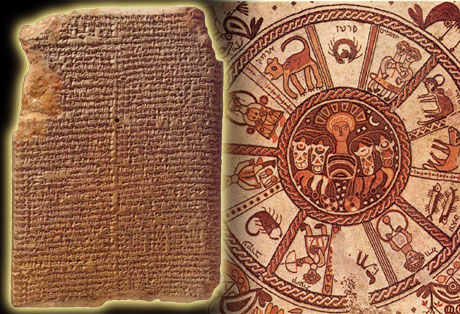One thing that struck me about yesterday’s article is the name MUL.APIN, with the dot in the center of the world which is similar to the translations by Zecharia Sitchin of the Sumerian texts which tell the stories that we find in our bible, and seem to indicate that the earth was populated by “gods” from other planets”:
“The ‘Eridu Genesis’…described the creation of man by the four great gods [the Anunnaki]: An [‘Sky’, the source of rain and most powerful of the gods], Enlil [‘Lord Wind’, the power in ‘Growing Weather’, creator of the hoe], Ninhursaga [‘Lady of the Stony Ground’, mother of wildlife], and Enki [rival of Ninhursaga]. After Nintur [Ninhursaga] had decided to turn man from his primitive nomadic camping grounds toward city life the period began when animals flourished on earth and kingship came down from heaven. The earliest cities were built, were named, had the measuring cups, emblems of a redistributional economic system, allotted to them, and were divided between the gods. Irrigation agriculture was developed and man thrived and multiplied. However, the noise made by man in his teeming settlements began to vex Enlil sorely, and, driven beyond endurance, he persuaded the other gods to wipe out man in an great flood. Enki, thinking quickly, found a way to warn his favorite, one Ziusudra. He told him to build a boat in which to survive the flood with his family and representatives of the animals.”
– Thorkild Jacobsen, The Treasures of Darkness
The translation of the MUL.APIN text can be found here. And sure enough, the text describes the “33 stars on the path of Enlil,” the wind god in the Sumerian texts – nearly 200 astronomical observations. Babylonia, Sumeria, Assyria – all, as Catherine points out in the comments, existed in what is now Iraq.
I have long been fascinated by the history of this area and the ancient Sumerian texts because of their implications on Judeo-Christian mythology. Most of what we find in the Bible was borrowed from other sources, robbing the Bible of its claim to have been written by God. Abraham, the patriarch of the three major religions of the Piscean age, was born in Ur which was in the Sumerian region when it was controlled by the Akkadians. The Assyrians, who were thought to have written the MUL.APIN texts according to the article in Nature, did not take over the region until the eighth century b.c.e. which corresponds with the dating by some astronomres of the MUL.APIN tablet to 687 BC. Evidently the Assyrians absorbed the Sumerian pantheon into their own and retained Enlil and Enki as major gods, but it seems likelythat the information from the MUL.APIN tablets actually originated much earlier to the actual Sumerian culture itself.

